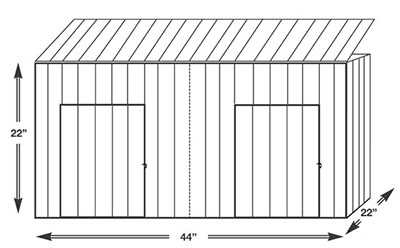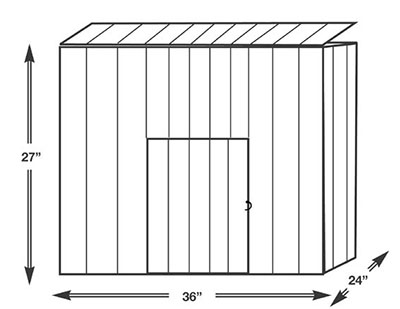Cages
Benching cages can vary in size from area to area, and the ones used on the East Coast are very different in size from those used on the West Coast. The cage size will be listed on the flyer.

East Coast double cage. The dotted line in the center indicates a single cage size. This cage can be considered as 2 single cages or 1 double cage. 1 single cage can accomodate 2 kittens or 1 adult. The entire cage can accomodate 2 adults or 4 kittens. It has 2 hinged doors on the front, and the top opens up, hinges on the front.

West Coast cage. Only one door and cannot be divided. Can accomodate 2 kittens or one adult.
Cage Curtains
Cage curtains – the material that drapes over and lines the benching cage – is a must! They both keep your cat comfortable as well as act as a ‘frame’ to show off your cat. Basic cage structure is one or two doors on the front of the cage, a hinged top that lifts up, and an open bottom. Do plan to use binder clips to secure the cage top to the bottom across the back and also across the sides as the hooks can damage curtain material. Use extra clips as necessary to keep your cat from exploring its way out of the top of the cage.
Curtains can be as simple as pieces of cloth clipped to the insides of the cage with a piece lying on the top and draping down the sides, to elaborate works of art that rival wedding dresses in their display. No matter their configuration, all curtains should be cleanable both to clean up whatever spills or mishaps happen, but to disinfect from any germs or viruses that may have been floating in the showhall.
Let’s take a look at some curtain configurations (measurements given are for the 22 x 22 x 44 cage. Adapt as needed for other sizes.)
Cage Body Piece – Use a piece of material at least 44 “ wide (for the 22” H) and at least 90” long (2 x 22” sides + 44” width) – preferably a few inches longer to give you some room to work with, or in case a cage is just a big longer/wider. There are 2 different methods for attaching this. The simplest is to fold the 44” side in half and clip the curtain so that half of its length runs inside the cage and half outside with the ends on the cage floor. However, some cats like to hide underneath the curtains. If you want to prevent this, put the curtain inside the cage and pull about 1/3 of the curtain under the bottom and clip it on the outside of the cage. Then bring the top of the curtain up and over the top of the cage, and clip it to the outside of the cage. Don’t worry that you have ends that don’t meet or look ‘rough’ – your top curtain will cover that right up.
Cage Top Piece – At least 22” wide and at least 90” long. Simply drape across the top of the cage and let the ends hang down the side. This is the piece that people really see, and that exhibitors often decorate the edges of to ‘frame’ the cat.
Bottom Piece – at least 48” wide ( you need it to stick out from the sides of the cage a bit and at least 36” long (longer if you want it to reach the floor). This simply lays underneath the cage and hangs down in front. If this piece will reach the floor, it will also cover up all the show gear that you stow underneath your cage. Vinyl tablecloths can make a good bottom piece as they will allow you to wipe up any spills your cat makes.
Divider – 22” deep x 44” long. Fold in half and drape across the top of the divider.
Materials
Curtain materials can be as simple or elaborate as you wish. Remember that you do want to wash your curtains between shows when you choose your materials. Supple polyesters and cottons are the easiest to work with as they are simple to clip into place. Some have the added advantage of folding down compactly for travel. Speaking of folding, take that into consideration when choosing material and choose a fabric that doesn’t wrinkle easily – that way your cage looks neat when you set it up. Sheer and semi-sheer materials are good for the top pieces as they allow some light to filter through. Your cat then won’t be quite so ‘in the dark’ and is shown off a little better. Some of the seasonal fabrics (such as for spring, summer, or Christmas) make great cage curtains – and they will be drastically reduced in price after that seasons’ end!
For the bottom, you can use the same material as the body. Some exhibitors use plastic or vinyl tablecloths or material as it is easy to wipe up should your cat spill its food or water (or have another type of accident). Or, you can use a traditional cloth bottom piece with a bottom-only size piece of clear plastic or complimentary colored plastic or vinyl if your cat is a messy one. Sew or attach a pocket to the front and you have an instant storage place for your show catalog or anything else.
You don’t sew? Look at materials that don’t fray and cut to size. Or use “Fray Check” or something similar on your rough edges, let it dry, then turn under and either hand baste into place, or use fusible seam binding.
Finally, should you decide that you have neither the time nor the talent, there are plenty of show curtain vendors across the country who have both ready made curtains or who will custom make ones for you.
Pop Up Cages
The “bubble cages” manufactured by Sturdi Products (among many other makers) have become very popular for use in the showhall. Their advantage is that they simply pop-up in the space where the regular wire cage would go, are impervious to spills, and good for males that might tend to spray. However, they can ‘cocoon’ the cat just a bit too much for the spectators to view them (this is often a complaint that the show committee hears…).
